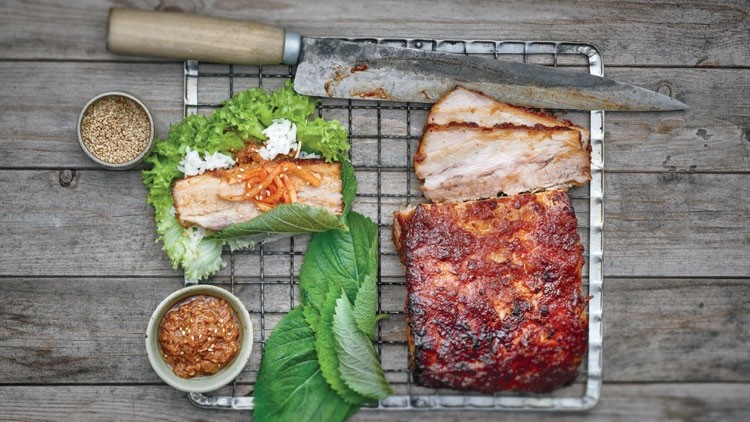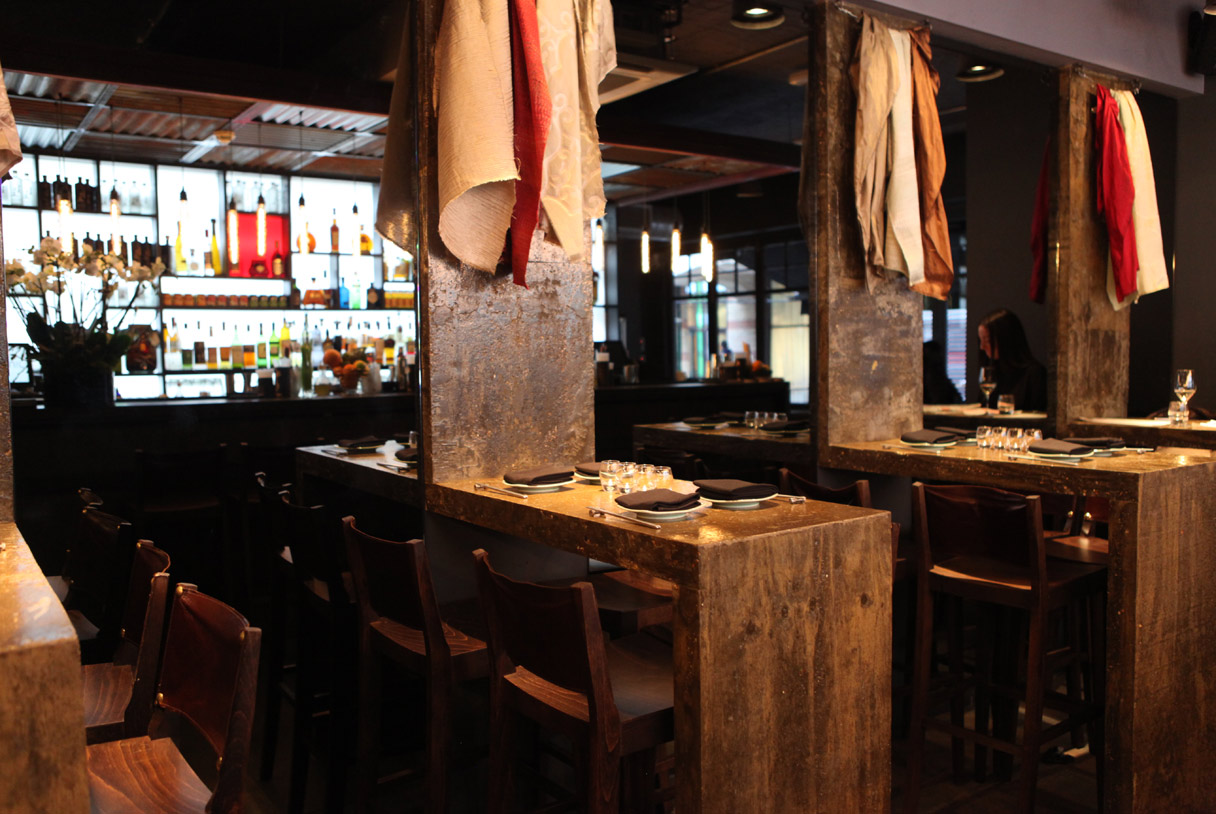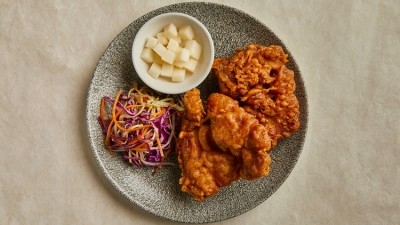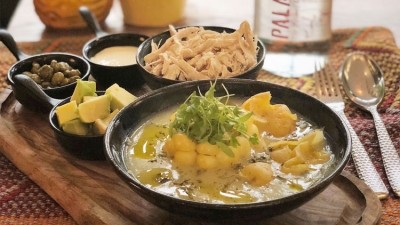Chef Masterclass: Bossam by Jinjuu's Judy Joo

"I'm not a super-traditional Korean cook,” says Judy Joo, chef and proprietor of Jinjuu in Soho. Take her version of bossam, the Korean dish of thinly-sliced pork belly wrapped in salad leaves with pickles and sauces.
“The classic way to cook the pork is just to boil it with salt, but I add doenjang (fermented soy bean paste) as well as onions, spring onions, garlic and ginger to create a sort of Asian courtbouillon. And I use Berkshire pigs: the meat isn’t too fatty, and I think pork belly is unctuous enough already. Leave the skin on and the bones in if you can: it helps to keep the belly’s texture and shape. And don’t discard the deliciously sticky cooking liquor: it makes a great base for a ramen soup. Even the skin can be dried and used to make crackling.”
Doenjang is one of Korean cuisine’s most versatile ingredients, cropping up as an ingredient or condiment in dozens of dishes. Made from fermented soy beans, it has a history dating back at least 2,000 years and has some similarities with Japanese miso, although, according to Joo, it is “funkier and stronger than miso, distinctively nutty, with a huge, complex hit of umami”.
More doenjang goes into the paste with which the belly is smeared before a final roasting, as well as honey to help caramelisation, grated ginger and gochujang, another Korean staple: fermented red chilli paste, made with glutinous rice and powdered soy beans.
“The soy bean powder gives it a really deep flavour,” says Joo. “It’s quite powerful: you need to thin it out, and cooking it soothes the heat.”
Doenjang and gochujang are also the basis of ssamjang, the sauce for the pork. The two pastes are thinned with rice wine, with sesame oil and seeds giving a nutty flavour and raw garlic and spring onion adding pungency. Joo includes a quick-pickled radish in her bossam, too. “In Korean cuisine you don’t just eat meat: there’s always a balance, a harmony. It’s the same as the ‘five elements’ theory of Chinese cookery: Korea even has yin/yang on its flag,” she says.
“There is an influence from the Japanese occupation of Korea, too, and the Korean way of eating straddles Chinese and Japanese. The concept of sharing underpins all Korean cuisine – it’s very convivial – and bossam is a good example: the food is served in the middle of the table, but everyone constructs their own bespoke parcels to suit their own tastes.”
In Korea, the radish pickle (ssamu) is made with mu, a local white radish unavailable in the UK, but daikon makes a good substitute.
“The pickle gives a welcome freshness to the dish,” says Joo. “It’s got the fiery hit of red kimchi and a bit of sweetness from the radish. In fact, the classic time to serve bossam is after making kimchi, usually in November – you use day-old kimchi in the wrap.”
The leaves add freshness, too. Joo uses perilla leaves – “a bit like shiso leaves, but hardier and hairier, with a distinct herbal flavour” – as well as lettuce leaves. The resulting wraps combine, in their various elements, salt, sour, sweet, bitter and spicy flavours, as well as bags of umami: the blandness of a little steamed rice helps to pull them all together. Joo’s other suggestion for a filling, however, should probably only be tried between consenting adults. “They’re really good with a few slices of raw garlic, too.”
■ Recipe adapted from Korean Food Made Simple, by Judy Joo, published by Jacqui Small, £22
Bossam (roasted pork belly lettuce wraps)
Ingredients (serves 4-6)
4 tbsp doenjang (Korean soy bean paste)
1 piece bone-in, skin-on pork belly (1.6kg to 1.8kg)
1 onion, cut into eighths
8 cloves garlic, crushed
7 spring onions, roughly chopped
6 thick slices unpeeled fresh ginger
2 tbsp honey
1 tbsp grated peeled fresh ginger
1 tsp gochujang (Korean chilli paste)
For the ssamjang
2½ tbsp doenjang (Korean fermented soybean paste)
2 tbsp gochujang chilli paste (Korean fermented chilli paste)
2 tbsp mirim (Korean mirin)
2 tsp roasted sesame oil
1 tbsp roasted sesame seeds
1 garlic clove, grated
1 spring onion, finely chopped
For the pickled radish
175g Korean white radish (mu) or mooli, peeled and julienned
1 tbsp Korean apple vinegar (sagwa-shikcho) or rice vinegar
1 tbsp sugar
1 tsp gochugaru (Korean chilli flakes)
1 small clove garlic, grated or finely chopped
1 tsp sea salt
To assemble the bossam
Red or green lettuce leaves
Perilla leaves (ggaennip), also known as sesame leaves (optional)
Steamed white rice
Method
1. In a large, wide, heavy-based saucepan, whisk 2 tbsp of doenjang with 240ml water until it is smooth. Add the pork belly, skin-side up, the onion, garlic, spring onions, sliced ginger and enough water to cover the meat. Bring the liquid to a boil over a high heat, then reduce the heat to a simmer and cook for 2 hours, until the pork is cooked through and very soft.
2. Transfer the pork belly to a baking sheet lined with foil and leave to cool: the cooking liquid can be strained and used in other dishes. When the pork is cool enough to handle, pull out the bones and slice off the skin (but not the fat) and discard.
3. In a small bowl, whisk together the remaining doenjang, honey, grated ginger and gochujang until smooth, then smear the paste all over the fat on the skin side of the pork.
4. Heat the oven to 180°C. Mix together the ingredients for the ssamjang sauce in a small bowl and reserve. In a medium bowl, stir the pickled radish ingredients together and refrigerate.
5. Roast the pork for 30 minutes until caramelised, then rest in a warm place for 15 minutes. Transfer to a chopping board and slice thinly into two-bite pieces.
6. Serve the pork on a platter with the lettuce, perilla leaves (if using), rice, sauce and pickled radish on the side. To assemble, put a lettuce leaf in one hand and top with a perilla leaf (if using), a spoonful of rice, a smear of sauce, a piece of pork and some pickled radish, then wrap the lettuce around the ingredients and eat.






















